Chapter 13
Reading Practice Test 2
Click here to download a PDF of Reading Practice Test 2.

READING TEST
35 Minutes—40 Questions
DIRECTIONS: There are four passages in this test. Each passage is followed by several questions. After reading each passage, choose the best answer to each question and blacken the corresponding oval on your answer document. You may refer to the passages as often as necessary.
Passage I
PROSE FICTION: This passage is adapted from the novel The Smell of Fresh Muffins by Woody Jessup (©1985 by Woody Jessup).
The narrator is going to help his grandfather paint a room in the narrator’s house. Garth is a friend of the narrator’s grandfather.


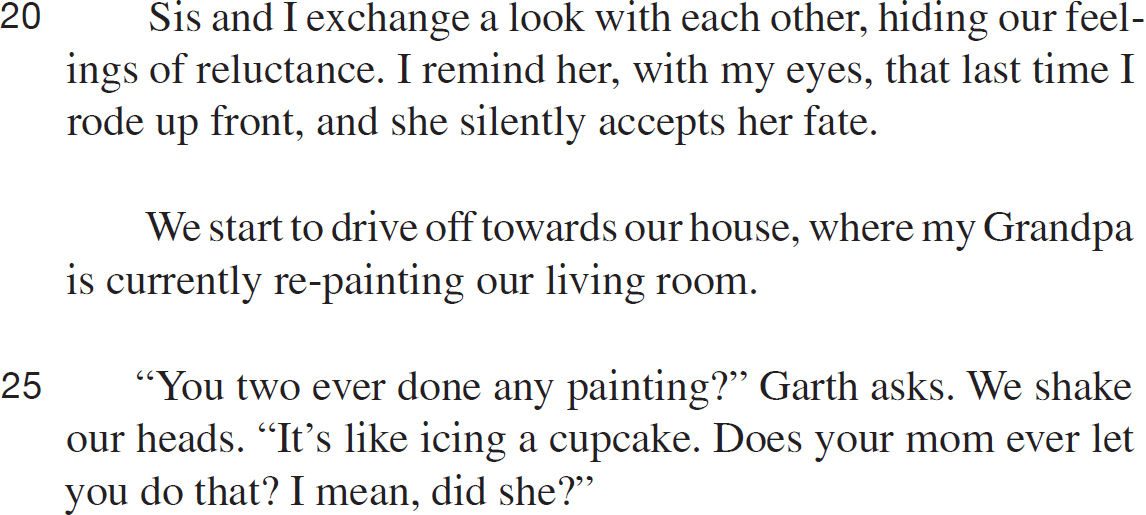

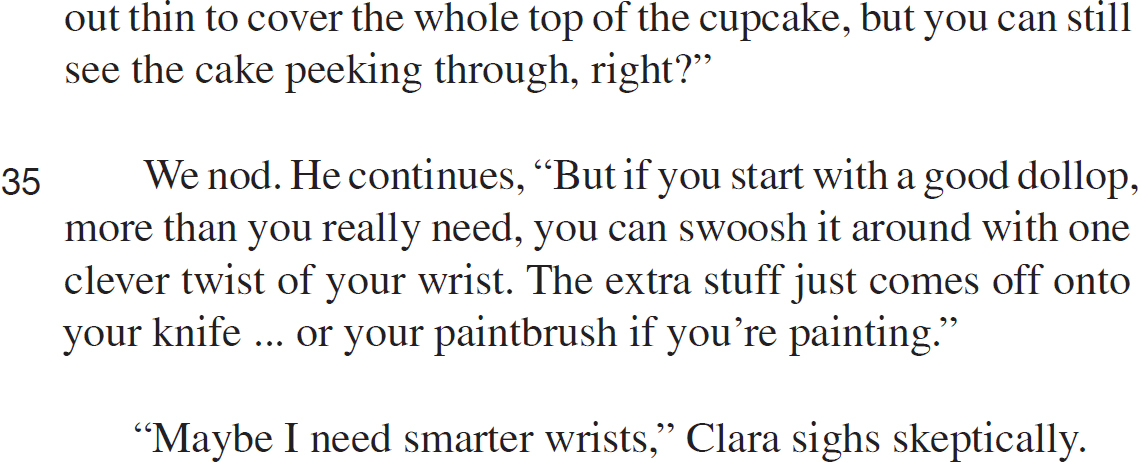

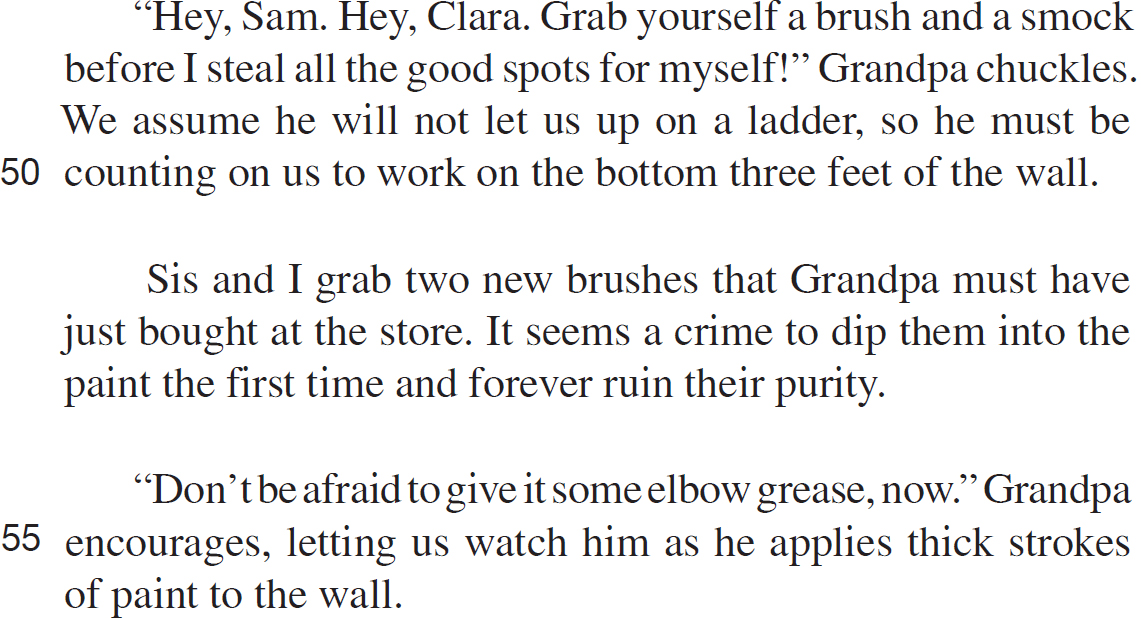
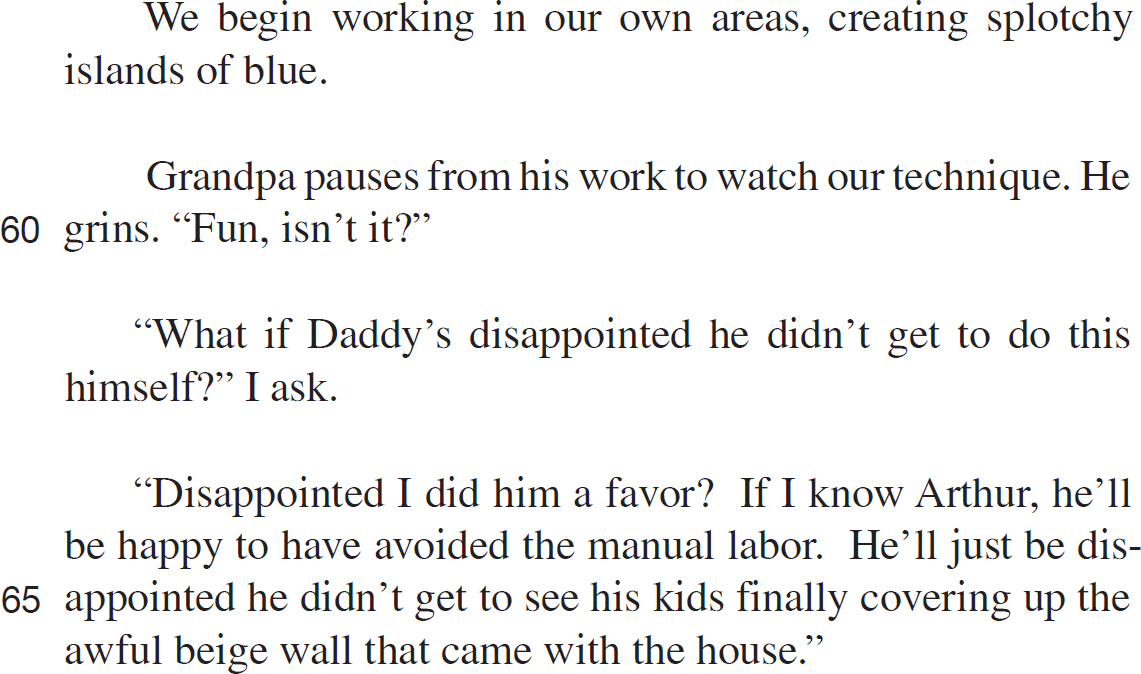


1. Which of the following statements regarding the idea for painting the room is best supported by the passage?
A. While Clara was reluctant to do it, Grandpa ultimately convinced her it was okay.
B. Garth suggested the idea to Grandpa, who then told the narrator and her sister.
C. Clara envisioned the idea, and Garth helped provide some of the supplies.
D. Although Grandpa planned the activity, Clara was involved in the decision making.
2. As presented in the passage, the exchange between the narrator and his sister when Garth comes to pick them up can best be described as:
F. an expression of frustration due to the curiosity the narrator and his sister felt regarding Garth’s unusual tardiness.
G. a situation that is initially confusing to the narrator until his sister reminds him about the project to repaint the living room.
H. a favorite game that the narrator plays with his sister to determine which person gets the honor of sitting in front.
J. a nonverbal conversation that allows the narrator and his sister to determine which of them receives an unfavorable consequence.
3. Based on the passage, Garth and Grandpa can be reasonably said to share all of the following characteristics EXCEPT:
A. painting experience.
B. good posture.
C. the ability to drive.
D. willingness to poke fun.
4. Clara’s reference to having smarter wrists (line 39) primarily serves to suggest her:
F. remaining doubt about equaling her mother’s skills.
G. growing excitement regarding learning how to paint.
H. deepening confusion about how painting relates to cupcakes.
J. increasing concern that people see her as intelligent.
5. Viewed in the context of the passage, Grandpa’s grin (lines 59–60) most nearly reflects a feeling of:
A. irony.
B. intense relaxation.
C. mild satisfaction.
D. harsh disapproval.
6. The narrator’s statement “His car is a good match for his personality” (line 14), most nearly means that in the narrator’s opinion, Garth is:
F. too conservative in his choice of cars.
G. highly dependable, but not very flashy.
H. more upright than many Oldsmobile drivers.
J. too concerned with how others see him.
7. Garth clearly recommends that the children apply both paint and icing in which of the following ways?
A. Gently
B. Respectfully
C. Conservatively
D. Confidently
8. In the second paragraph, the main conclusion the narrator reaches is that:
F. Garth considers tardiness a character flaw.
G. Garth is extremely talented at organizing his schedule.
H. people can use a routine to avoid focusing on something painful.
J. Grandpa is a very keen observer of human behavior.
9. In terms of the development of the narrator as a character, the last paragraph primarily serves to:
A. add to the reader’s understanding of his guilt.
B. explain his relationship to his mother.
C. describe his underlying emotional conflict.
D. portray the strained relationship he has with Grandpa.
10. It can most reasonably be inferred that Arthur is the name of:
F. Garth and Grandpa’s friend.
G. the narrator.
H. the narrator’s father.
J. the neighbor who lent them the ladder.
Passage II
SOCIAL SCIENCE: The following is an excerpt from the article “Electric Cars Face Power Outage” by Justin Sabo (© 2010 by Justin Sabo).

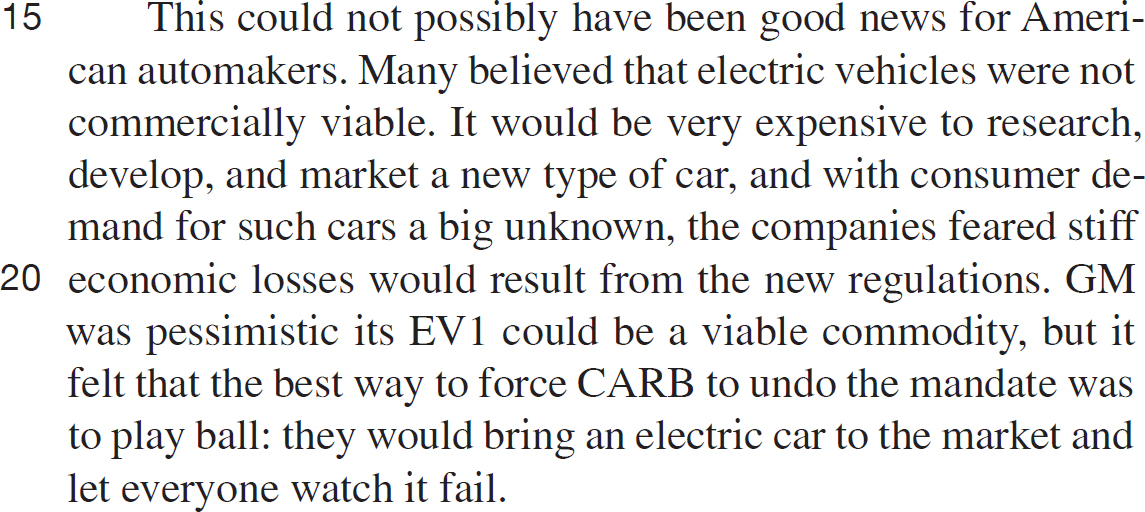
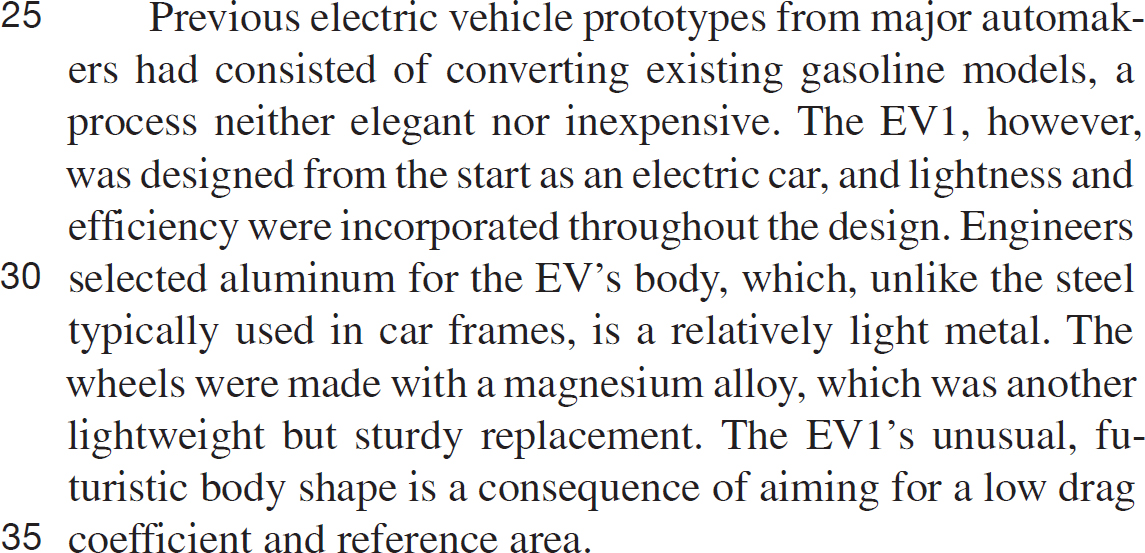

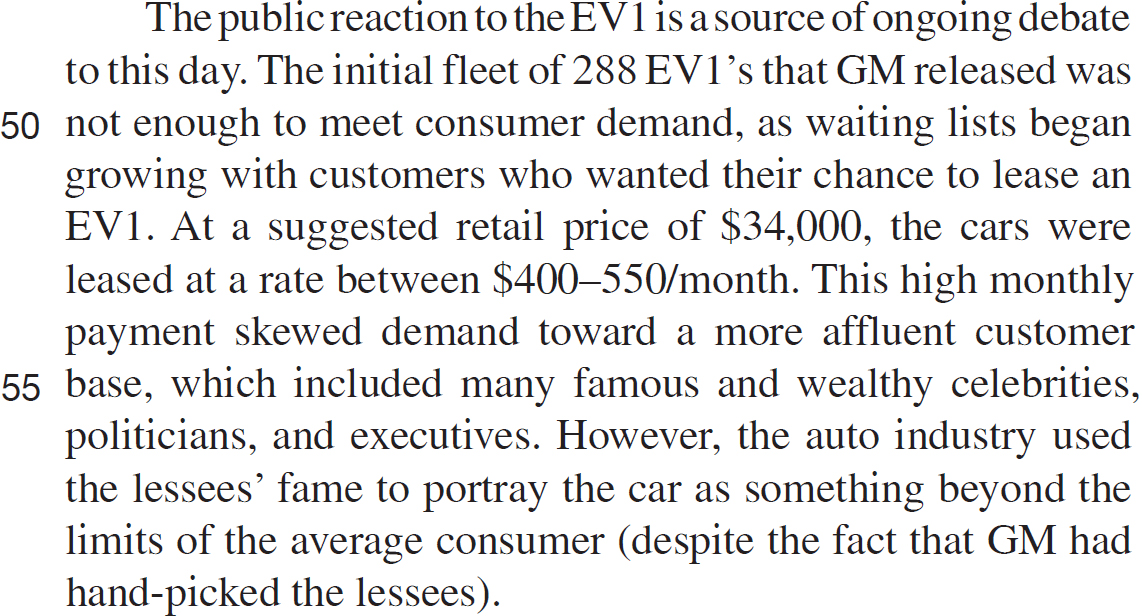


11. The author implies that for an electric car to be more appealing to most car buyers, the most important factor would be changing which of the following?
A. Body shape
B. Distance per charge
C. Aluminum frame
D. Price
12. The statement in lines 16–17 most likely represents the view of all of the following groups EXCEPT:
F. the executives at GM who commissioned the design of the EV1.
G. the members of the California Air Resources Board who issued the mandate.
H. the other American automakers at the time the CARB mandate was issued.
J. Dr. Kenneth Train and his research team at UC Berkeley.
13. According to the passage, the number of drivers who first leased an EV1 was around:
A. 70–100.
B. 288.
C. 400–550.
D. 12–18% of the light duty market.
14. The author most nearly portrays the efforts of GM to design an electric car as:
F. resulting from overconfidence in estimating consumer enthusiasm for electric vehicles.
G. directed more at perfecting the marketing than at perfecting the science.
H. intended to showcase GM’s superiority over its competitors.
J. motivated in part by a desire to fail.
15. According to information presented in the fourth paragraph (lines 25–35), which of the following comparisons between previous electric vehicle prototypes and the EV1 would the author make?
A. The EV1s were more deliberately and insightfully designed.
B. The EV1s were just converted from previous gasoline prototypes.
C. The previous electric prototypes were basically the same as the EV1.
D. The previous electric prototypes were made out of cheaper, lighter materials.
16. Based on information presented in the sixth paragraph (lines 48–59), it can reasonably be inferred that which of the following determinations would have the biggest effect on the potential marketability of electric vehicles?
F. The strength of affiliation that most car buyers have for environmental organizations
G. Whether most car buyers would consider buying an automobile that costs more than one powered by gasoline
H. How many other states might enact regulations similar to that of CARB’s in California
J. The extent to which most car buyers identify with wealthy politicians and celebrities
17. According to the passage, aluminum’s role in the EV1 was:
A. a lightweight wheel.
B. to lower drag coefficient.
C. an alternative to steel.
D. magnesium alloy substitute.
18. The author most likely intends his answer to the question posed in line 66 to be:
F. definitive; he believes the real reasons are plain to see.
G. incomplete; he is convinced that CARB had some unknown involvement.
H. genuine; he is unsure about GM’s motives for the denial.
J. speculative; he thinks that plausible explanations have been put forth.
19. The author indicates that one cause behind GM reclaiming EV1’s from their owners may have been:
A. the unwillingness of owners to renew their leases.
B. CARB’s decision to change the terms of its original low-emissions mandate.
C. a financial disincentive GM would face should the EV1 become popular.
D. customers’ sticker shock at the $28,000 price tag.
20. It can reasonably be inferred from the last paragraph that the author thinks that any forthcoming electric vehicle will:
F. have to solve non-technological problems.
G. be embraced by most automakers.
H. overcome the skepticism of consumers.
J. succeed if sold at a lower price.
Passage III
HUMANITIES: The following passage is adapted from the essay “The Torres Revolution” by Greg Spearman (©2001 by Greg Spearman).

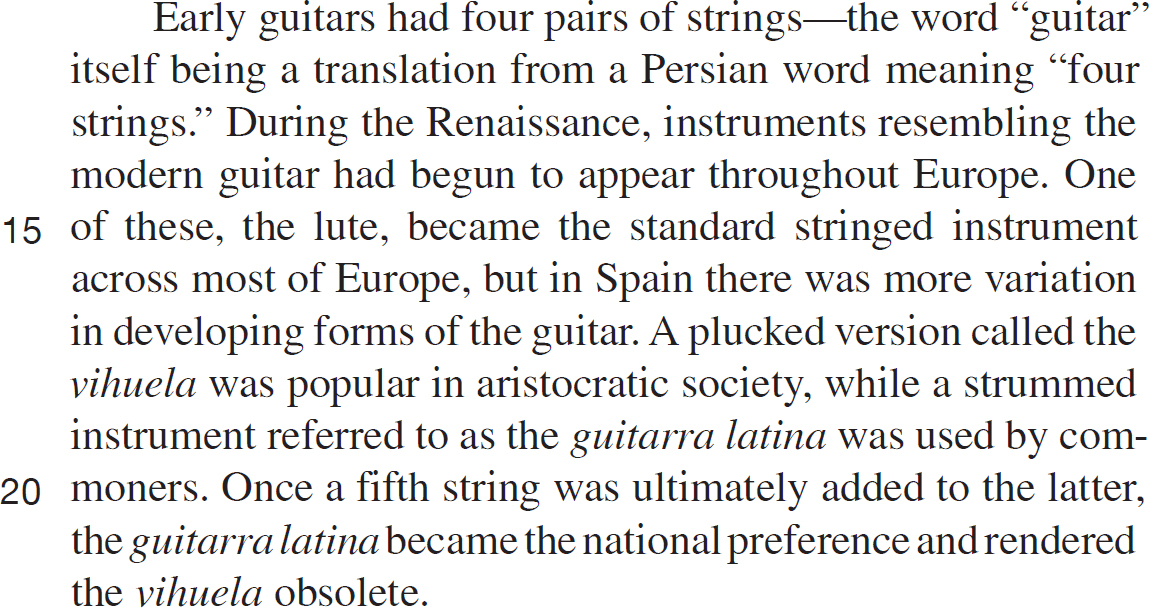
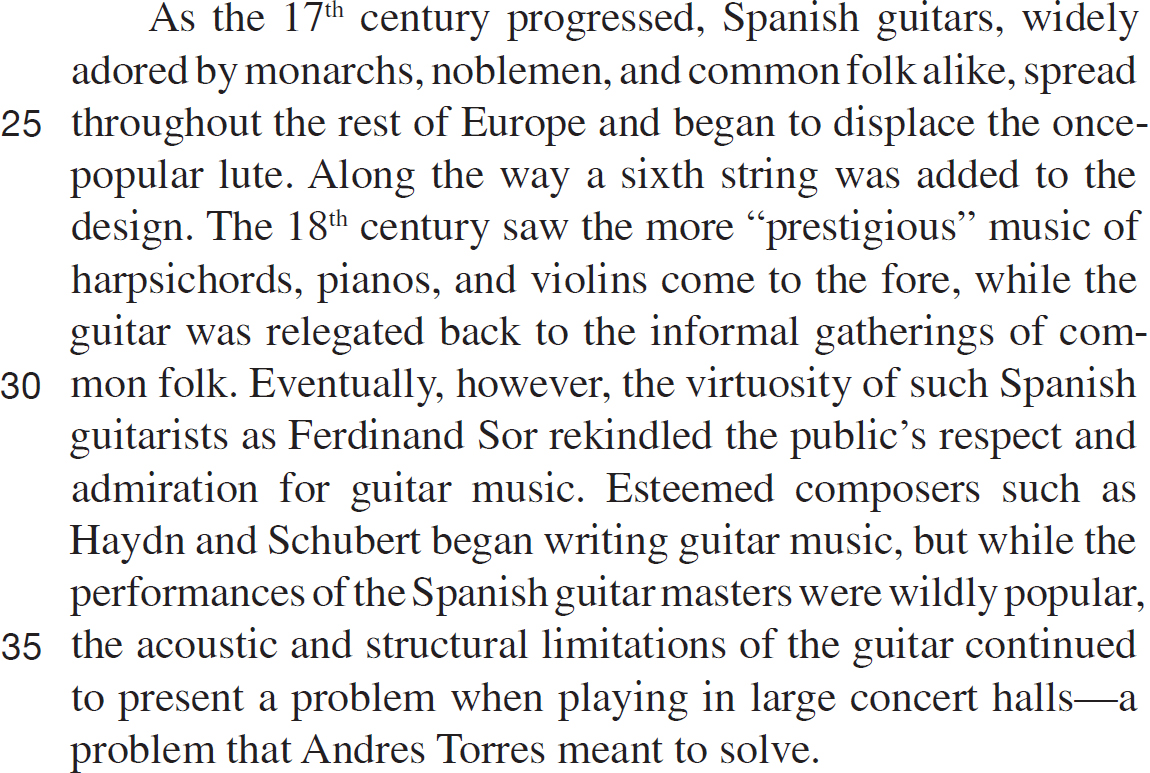
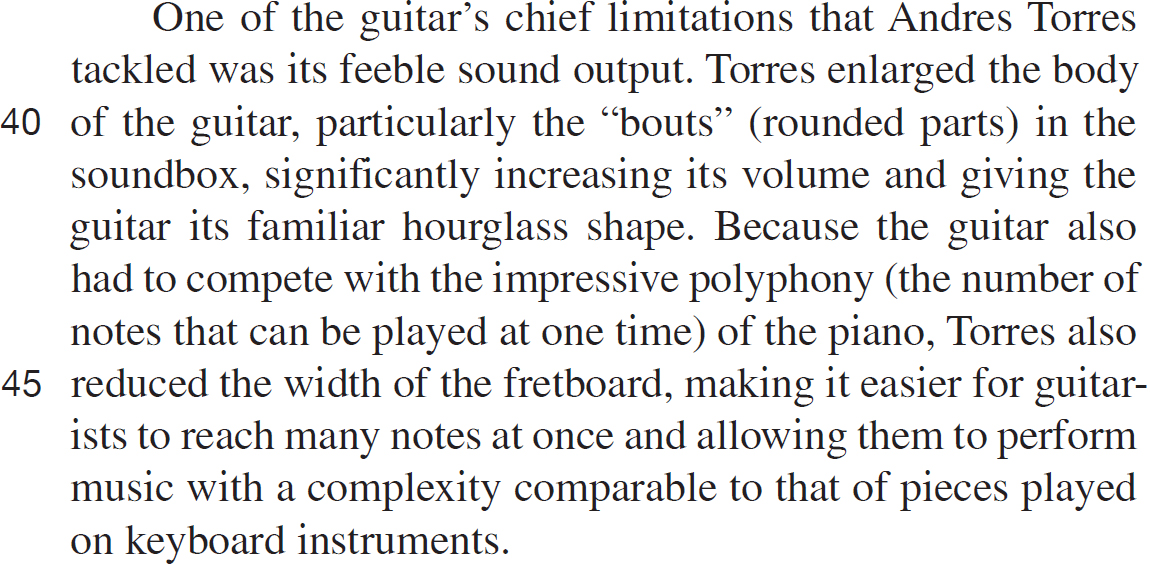

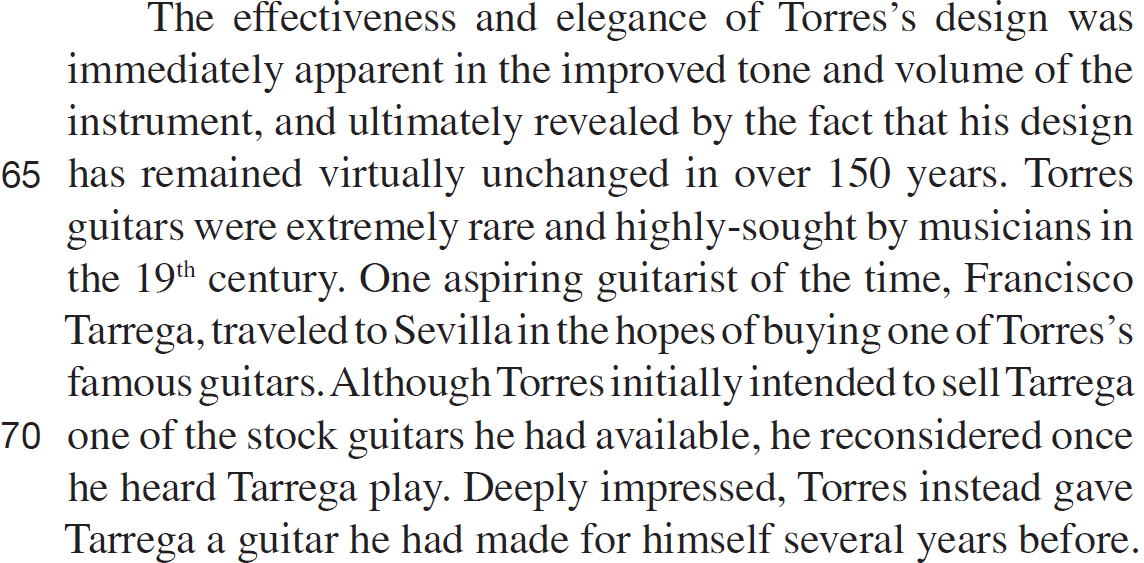
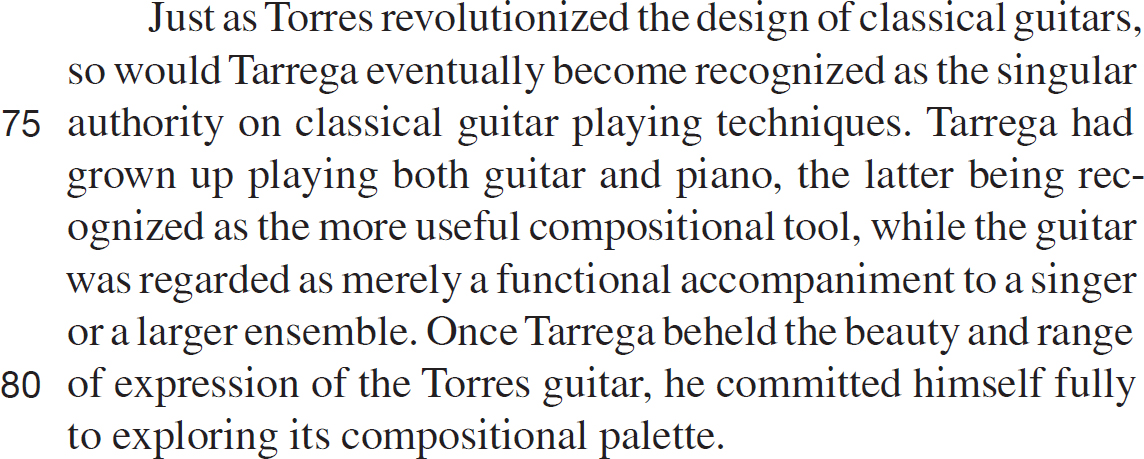
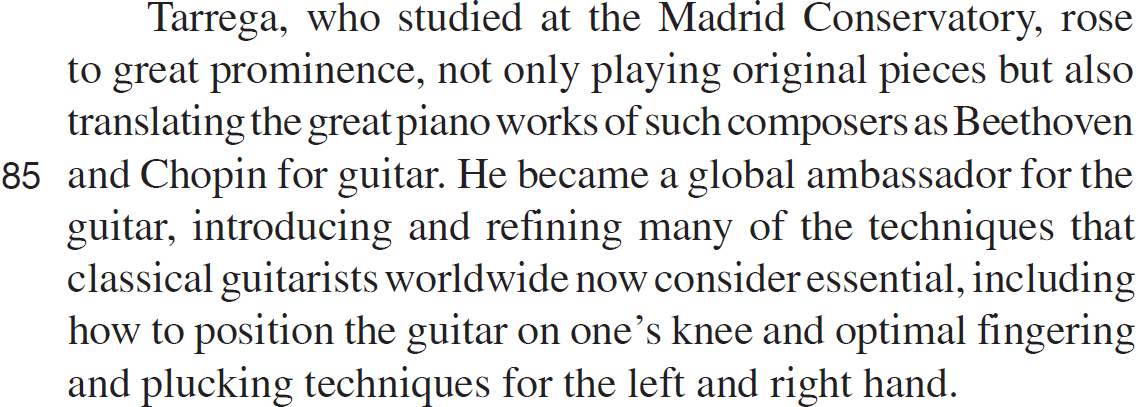
21. Based on the passage, the author would most likely agree that both Torres and Tarrega were:
A. not fully appreciated for their musical genius until after their deaths.
B. local sensations whose reputation never reached the global fame of other composers.
C. extremely influential contributors to the evolution of classical guitar playing.
D. very talented instrument makers who gained much fame for their talents.
22. As it is used in lines 49–50, the phrase the genius of Torres’s design most nearly refers to the:
F. innovative idea that classical guitars could be the centerpiece of a performance, rather than merely an accompaniment.
G. improved tonal quality and volume resulting from the number and positioning of wooden braces within the soundbox.
H. invention of an arched neck, which counters the effects of the tension caused by the tightly wound strings.
J. expansion of the width of the guitar, in order to accommodate a sixth string and allow for more polyphony.
23. Which of the following statements best describes how the second paragraph (lines 11–23) relates to the first paragraph?
A. It provides supporting details concerning Torres’s innovative idea to use a fifth string.
B. It compares the modern guitar to its earlier relatives, such as the lute and vihuela.
C. It moves the discussion to a period that predates the innovator described in the first paragraph.
D. It counterbalances the argument in the first paragraph by providing details that suggest early guitars were superior in many ways to later guitars.
24. As it is used in line 81, the phrase compositional palette most nearly means:
F. artistic potential.
G. colorful components.
H. volume output.
J. physical features.
25. For purposes of the passage, the significance of Spanish guitarists such as Ferdinand Sor is that they:
A. were reluctant to accept modifications to the traditional design of the guitar.
B. gave Torres suggestions about his design.
C. were among the most talented lute players in Europe at the time.
D. helped develop and sustain interest in the guitar as a reputable instrument.
26. Which of the following questions is NOT answered by the passage?
F. What is the meaning of an instrument’s polyphony?
G. When was the beginning and the ending of the Renaissance?
H. Who is the father of the modern guitar?
J. What were some of the earlier forms of the guitar?
27. According to the passage, the vihuela was a Renaissance version of the guitar that:
A. was ultimately overtaken in national popularity by another type of guitar.
B. became the Spanish aristocrats’ version of the lute.
C. initially came to fame through the notoriety of Ferdinand Sor.
D. one of Torres’s earlier models before he perfected his fan-bracing design.
28. According to the passage, the Torres guitar was better suited than previous versions of the guitar to:
F. Beethoven’s works.
G. being a featured instrument.
H. five strings.
J. folk music.
29. According to the passage, the popularity of Spanish-style guitars during the 18th century was:
A. increasing due to the simultaneous decline in popularity of the lute.
B. aided by the growing popularity of other instruments that complemented the guitar’s sound.
C. hindered by common folk’s inability to master fingering and plucking techniques.
D. diminished by the perception that it was not as refined as other contemporary instruments.
30. It can most reasonably be inferred that which of the following was a direct expression of respect for Tarrega’s playing abilities?
F. The manner in which Torres determined which guitar he would sell to Tarrega.
G. The translation of Beethoven’s and Chopin’s works from piano to guitar.
H. The eventual end to the popularity of the guitarra latina.
J. The way Haydn and Schubert began composing music specifically for guitar.
Passage IV
NATURAL SCIENCE: The following passage is adapted from the article “Heavyweights of the Sea” by Carmen Grandola (©2001 by Carmen Grandola).
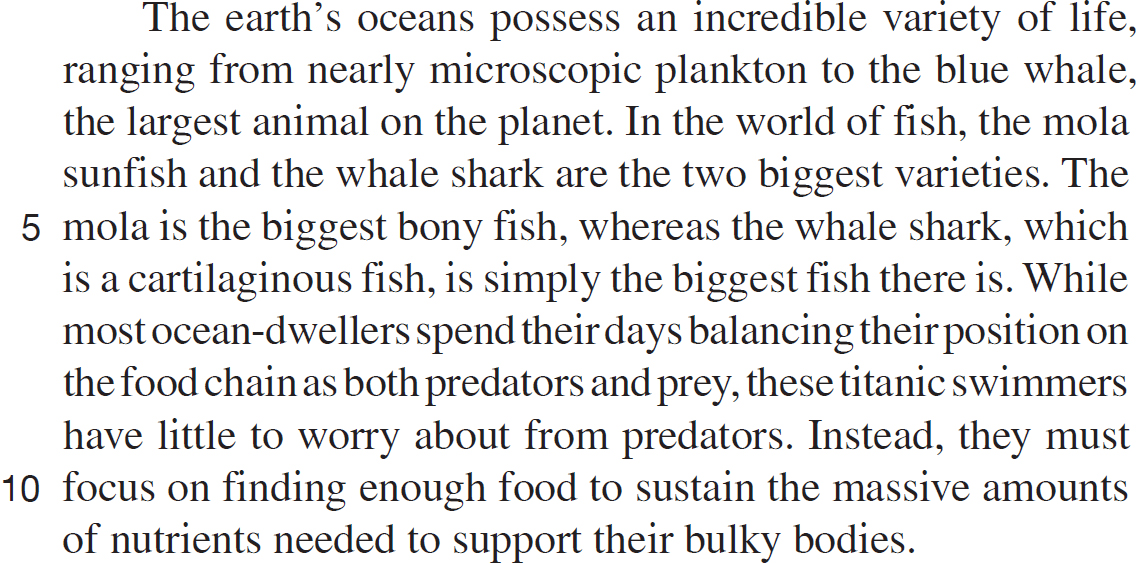

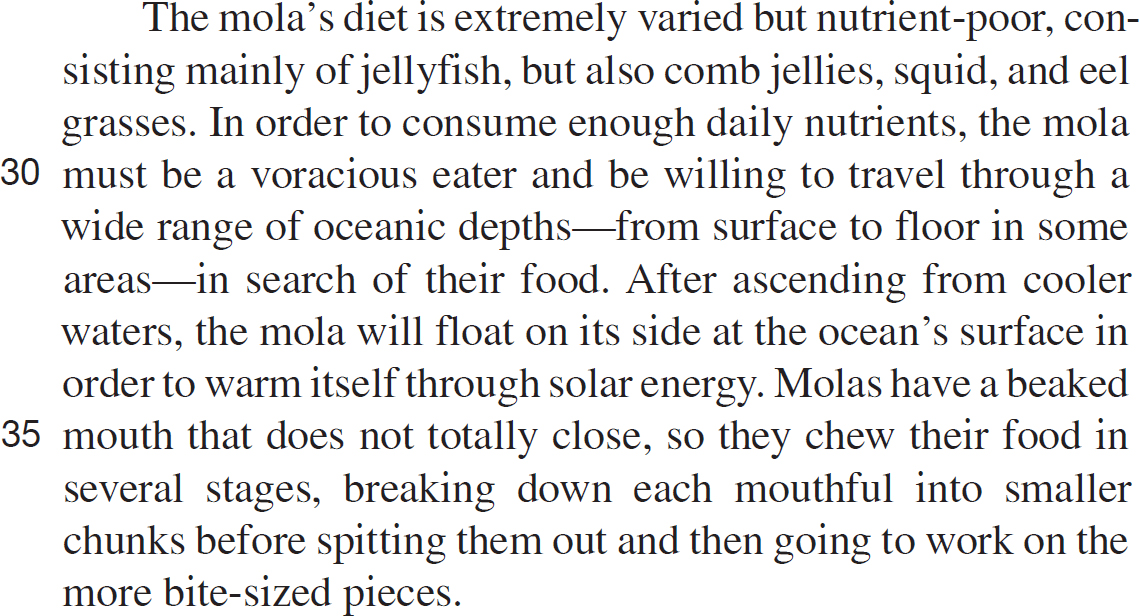



31. The author’s attitude regarding molas and whale sharks can best be described as one of:
A. conviction that human interference will ultimately jeopardize each species.
B. resentment towards their need to eat so much other marine life on a daily basis.
C. impartiality in considering the perils of their environment compared to other fish.
D. interest in how their grandiose size affects their habits and survival.
32. It can reasonably be concluded from the passage that the mola temporarily expels its food when eating due to the fact that it:
F. is a bony fish rather than a cartilaginous one.
G. possesses a mouth that cannot completely close.
H. hunts on the ocean floor but eats at the surface.
J. is normally floating on its side near the surface.
33. According to the passage, the most significant difference between the predatory threats facing the whale shark and the mola is that the whale shark:
A. does not compete for the same food as its predators do, while the mola competes for the same food its predators do.
B. is unaffected by its proximity to humans while the mola is sometimes endangered by humans.
C. faces few genuine environmental threats but must contend with the nuisance of parasites.
D. is less likely to be attacked by another ocean-dwelling species than is the mola.
34. It can most reasonably be inferred from the passage that nautical vessels pose a threat to both the mola and the whale shark primarily because these vessels:
F. can sometimes unsuspectingly collide with fish.
G. stir up a violent wake that disrupts the ocean currents.
H. jettison large debris overboard which can land on fish.
J. deplete the fish’s supply of prey through over-fishing.
35. The passage indicates that the quantity of food a fish must eat is primarily determined by the:
A. mass of the fish’s body.
B. depth at which the fish hunts.
C. type of gill rakers it has.
D. number of its teeth and size of its mouth.
36. The passage supports the idea that all of the following are included in the diet of the mola EXCEPT:
F. comb jellies.
G. zooplankton.
H. eel grasses.
J. squid.
37. The main purpose of the last two paragraphs is to:
A. provide additional support for the earlier claim that the mola and the whale shark are two of the biggest creatures inhabiting the ocean.
B. convey to the reader to the ironic fact that such large species of fish can be vulnerable to miniature threats such as parasites.
C. summarize the types of threats, or lack thereof, present in the environments of the mola and whale shark.
D. demonstrate the fact that even the biggest fish in the sea have to worry about being preyed upon by something.
38. According to the passage, the gill rakers a whale shark has are primarily intended to:
F. spit out partially chewed food.
G. rip apart the whale shark’s large prey.
H. bridge together its 300 rows of teeth.
J. filter out food from a mouthful of water.
39. According to the passage, the Latin-derived name for the mola refers to the:
A. atypical rounded clavus of the mola.
B. mola’s distinctive half-fish shape.
C. voracious eating the mola’s diet requires.
D. mola’s enormous size and weight.
40. The main purpose of the passage is to:
F. offer support for the notion that the mola is pound-for-pound a better hunter than is the whale shark.
G. provide a general overview of the habitats, eating habits, and survival challenges relating to two of the biggest species of fish.
H. increase awareness for the fragile status of mola and whale shark populations and encourage conservationists to intervene.
J. suggest that the unlikely traits possessed by the mola and the whale shark do not have clear evolutionary answers.
END OF TEST 3
STOP! DO NOT TURN THE PAGE UNTIL TOLD TO DO SO.
DO NOT RETURN TO A PREVIOUS TEST.